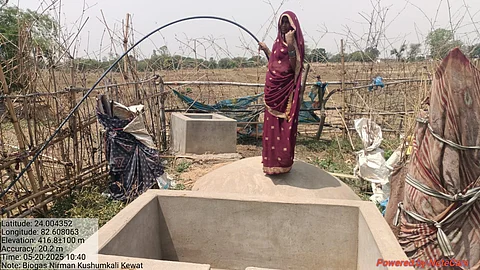

In Pipra village, Madhya Pradesh, over half the households have installed low-cost Deenbandhu biogas plants, replacing firewood, kerosene and LPG.
Women have led the shift, saving families Rs 800–1,100 a month and improving health by eliminating smoke-filled kitchens.
Biogas reduces deforestation and methane emissions, while the slurry by-product boosts organic farming.
Experts say household air pollution is a major global health threat, responsible for 3.1 million premature deaths in 2021.
In Pipra village and its neighbouring settlements in Singrauli district, it is now rare to see anyone hauling firewood, liquefied petroleum gas (LPG) cylinders or bottles of kerosene. In just ten months, a quiet energy revolution has taken place: More than half the households in the village — 71 in total — have installed biogas plants, with women leading the charge.
“Today, thanks to the tireless efforts of these women, each household is saving between Rs 800 and Rs 1,100 a month on LPG cylinders alone,” said Raksha Singh, coordinator of the Deenbandhu Model biogas plant scheme, which has driven the change. She added that families are also saving on firewood, kerosene and electricity bills, while women are enjoying cleaner kitchens free from smoke.
For residents like Neelu Ves, the shift has been life-changing. “With biogas, we no longer have the headache of worrying about where to get a cylinder, wood or kerosene,” she said. “Earlier, a major part of our day, even our month, was spent just arranging fuel.”
The Deenbandhu Model biogas plant, designed to be low-cost and suited to rural needs, generates gas from cow dung and organic waste for cooking. The by-product, a nutrient-rich slurry, is used as an organic fertiliser to boost crop yields. According to the Union Ministry of New and Renewable Energy, biogas plants offer a practical clean-energy solution for rural India, with environmental and socio-economic benefits.
Singh explained that 70 per cent of the dung used in a biogas plant returns as slurry within 24 hours. The odourless fertiliser can be applied directly to fields, either wet or dried. “With biogas, rural households will be able to practise natural and organic farming without additional effort,” she said.
The environmental benefits are equally significant. Rural households traditionally burn about 5 kilogrammes of firewood a day, which over two months consumes the equivalent of a full-grown tree. Open cow dung, meanwhile, releases methane — a potent greenhouse gas. Converting it to biogas prevents this release, helping to mitigate climate change.
Each cubic metre of biogas generates about 1.25 kilowatt hour of green energy, Singh said and large-scale adoption could even open up opportunities for carbon credits. “These women have taken a significant step towards protecting the environment and making life easier for other rural women like themselves,” she added.
Pipra now stands out among Singrauli district’s 416 villages as a model of rural energy self-reliance — one where women have led a transformation that is saving money, improving health and quietly reshaping the local environment.
Globally, billions of people in developing countries still cook over kerosene stoves, charcoal grills or wood fires, often indoors. The smoke from these fuels is laden with toxic particles, posing a severe health risk. In 2021 alone, household air pollution was linked to 3.1 million premature deaths. It also drives deforestation, biodiversity loss and climate change. Further, household air pollution is one of the biggest public health threats in the world and it is especially dangerous for children, according to the United Nations Environment Programme.
A 2021 study had found that burning solid fuels such as coal and wood for cooking can pose a damage to the eyes and cause blindness.